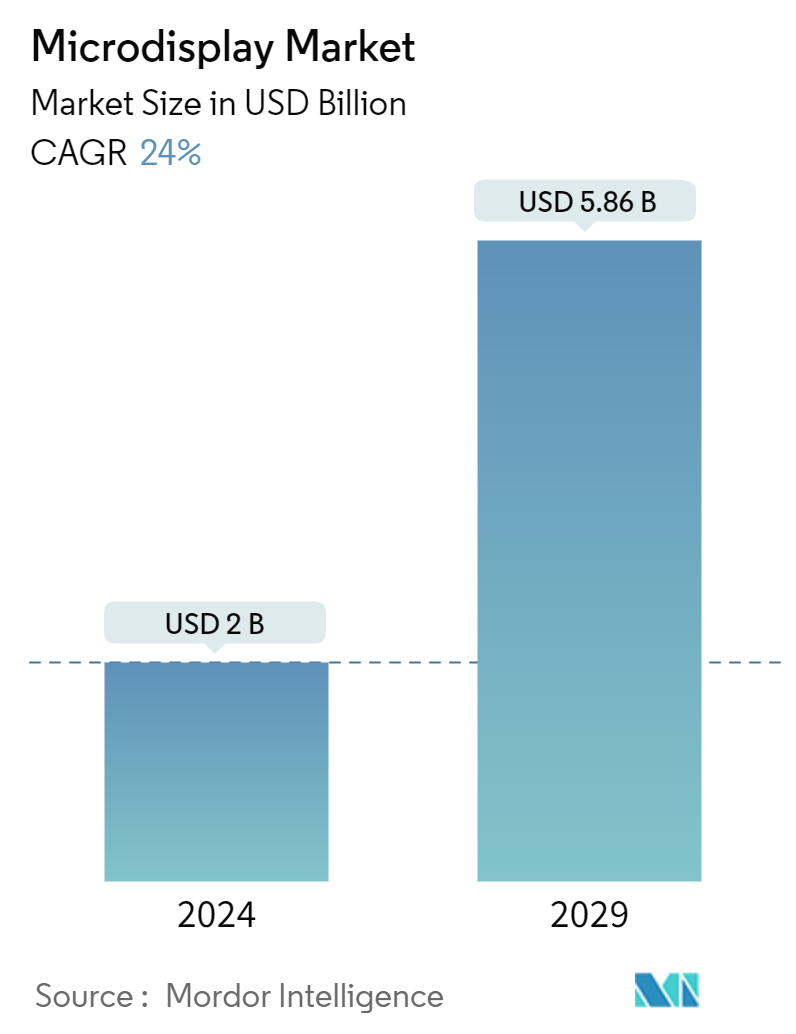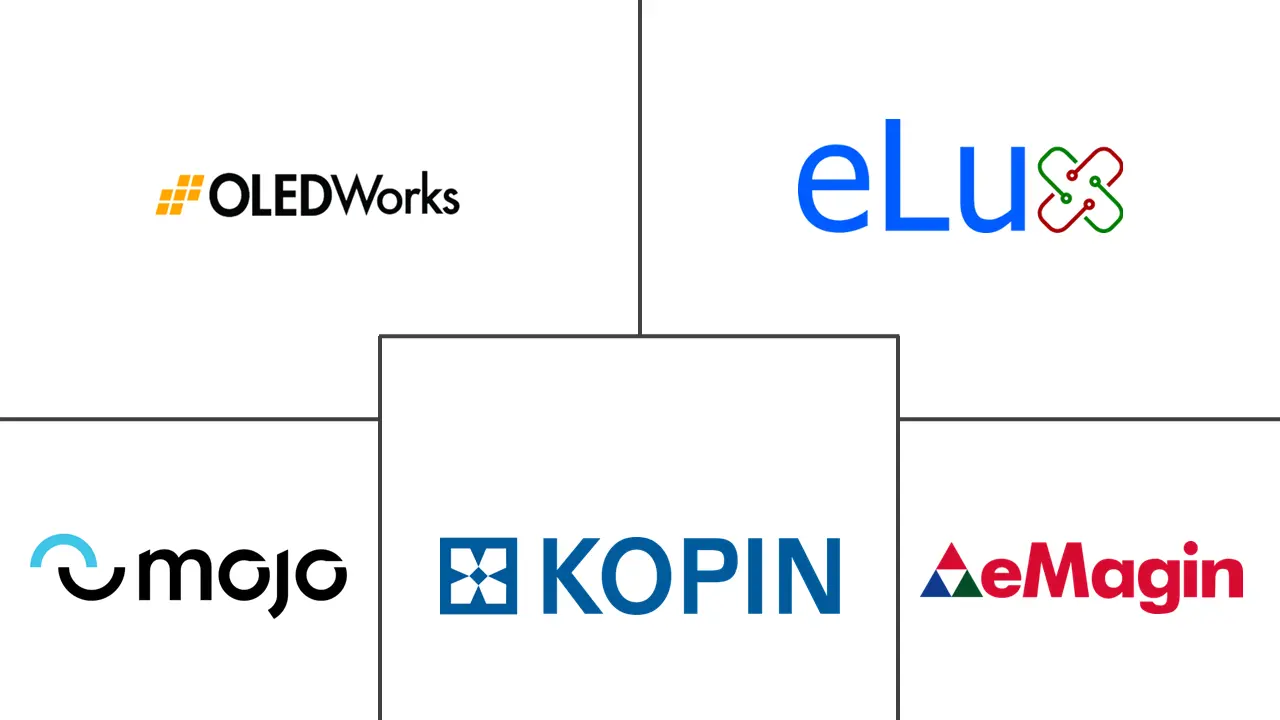Market Size of Microdisplay Industry

| Study Period | 2019 - 2029 |
| Market Size (2024) | USD 2 Billion |
| Market Size (2029) | USD 5.86 Billion |
| CAGR (2024 - 2029) | 24.00 % |
| Fastest Growing Market | Asia Pacific |
| Largest Market | Americas |
| Market Concentration | Low |
Major Players
*Disclaimer: Major Players sorted in no particular order |
Microdisplay Market Analysis
The Microdisplay Market size is estimated at USD 2 billion in 2024, and is expected to reach USD 5.86 billion by 2029, growing at a CAGR of 24% during the forecast period (2024-2029).
- Modern devices are rapidly becoming compact, portable, and convenient and are used to present graphical and pictorial information. These devices must be compact and straightforward with a high-resolution display. The market for microdisplays is growing significantly as more people consider using EVFs or projectors in several sectors. Given that demand for AR smart glasses is set to increase over the next few years, microdisplays have vital growth potential.
- Microdisplays contribute to market growth for drivers and passengers by providing critical information when integrated into ADAS (advanced driver assistance systems) or autonomous vehicles. Research and development efforts are focused on manufacturing flexible and foldable microdisplays that will allow new form factors for a wide range of mobile devices and wearables.
- Most HMD systems use LCD microdisplays because they have excellent image quality and a small form factor. Magnifiers, eyepieces, or projection lenses may be used for collimating optics. A compact and light system with high image performance is always preferred for HMD systems. Technological developments in technology and immersive experiences have led to a surge in demand for head-mounted displays, especially in the gaming and entertainment sectors. Concurrently, market growth for microdisplays is driven by the increasing adoption of HMDs in health monitoring devices in healthcare, defense, and education.
- The cost of producing microdisplays can be considerable, particularly for those with advanced features such as large resolution and brightness. This may lead to reduced adoption, particularly in cost-sensitive consumer electronics applications. Microdisplays have complex production processes for the manufacture of semiconductors, requiring specialized facilities and qualified personnel. As a result, production delays and higher costs can occur, thus hindering the market's growth.
- While there have been substantial advances in microdisplays over the years, macroeconomic factors, such as several engineering issues, still exist, which prevent them from being broadly adopted for numerous challenging applications, including virtual reality head-mounted displays. The critical challenge for microdisplay manufacturers is expected to be the development of many collections that are compact in form factor and achieve a wide field of view and high resolution.
Microdisplay Industry Segmentation
For market estimation, the revenue generated from the sale of types of technology offered by different market players for a diverse range of applications is tracked. The market trends are evaluated by analyzing the investments made in product innovation, diversification, and expansion. Further, advancements in consumer and automotive defense applications are crucial in determining the growth of the market studied.
The microdisplay market is segmented by type of technology (traditional [LCOS, LCD, DLP], OLED-on-si, microLED), application (consumer and automotive [augmented reality/virtual reality headsets, automotive HUDs, traditional applications {projection/camera}], defense), and geography (North America, Europe, Asia-Pacific, Middle East and Africa, and Latin America). The market sizes and forecasts are provided regarding value (USD) for all the above segments.
| By Type of Technology | |
| Traditional (LCoS, LCD, DLP) | |
| OLED-on-Si | |
| MicroLEDs |
| By Application | |||||
| |||||
| Defense | |||||
| Others |
| By Geography*** | |
| North America | |
| Europe | |
| Asia | |
| Australia and New Zealand | |
| Middle East and Africa | |
| Latin America |
Microdisplay Market Size Summary
The microdisplay market is poised for significant expansion, driven by the increasing demand for compact, high-resolution displays in various sectors such as consumer electronics, automotive, and healthcare. As devices become more portable and integrated with advanced technologies, microdisplays are becoming essential components, particularly in applications like augmented reality (AR) and virtual reality (VR). The automotive industry, in particular, is witnessing a surge in the adoption of microdisplays for advanced driver assistance systems (ADAS) and heads-up displays (HUDs), enhancing the driving experience by providing critical information to drivers. The gaming and entertainment sectors are also contributing to market growth, with head-mounted displays (HMDs) gaining popularity due to their immersive experiences. Despite the high production costs and complex manufacturing processes, the market is expected to grow as technological advancements continue to improve the performance and affordability of microdisplays.
Regionally, the Asia-Pacific market is experiencing robust growth, fueled by the thriving electronics and automotive industries in countries like China, Japan, South Korea, and India. The demand for microdisplays is further bolstered by government initiatives in India, promoting technological adoption and industrial growth. Key players in the market, including LG Electronics, Samsung, and Sony Group, are investing heavily in developing innovative microdisplay technologies to maintain their competitive edge. Collaborations and partnerships among companies are also on the rise, aiming to enhance product offerings and expand market reach. As the market becomes increasingly competitive, companies are focusing on introducing new products and technologies to capture a larger share of the growing microdisplay market.
Microdisplay Market Size - Table of Contents
-
1. MARKET INSIGHTS
-
1.1 Market Overview
-
1.2 Industry Attractiveness - Porter's Five Forces Analysis
-
1.2.1 Threat of New Entrants
-
1.2.2 Bargaining Power of Buyers/Consumers
-
1.2.3 Bargaining Power of Suppliers
-
1.2.4 Threat of Substitute Products
-
1.2.5 Intensity of Competitive Rivalry
-
-
1.3 Technology Snapshot
-
1.4 Impact of COVID-19 Aftereffects and Other Macroeconomic Factors on the Market
-
-
2. MARKET SEGMENTATION
-
2.1 By Type of Technology
-
2.1.1 Traditional (LCoS, LCD, DLP)
-
2.1.2 OLED-on-Si
-
2.1.3 MicroLEDs
-
-
2.2 By Application
-
2.2.1 Consumer & Automotive
-
2.2.1.1 Augmented Reality/Virtual Reality Headsets
-
2.2.1.2 Automotive HUDs
-
2.2.1.3 Traditional Applications (Projection/Camera, Others)
-
-
2.2.2 Defense
-
2.2.3 Others
-
-
2.3 By Geography***
-
2.3.1 North America
-
2.3.2 Europe
-
2.3.3 Asia
-
2.3.4 Australia and New Zealand
-
2.3.5 Middle East and Africa
-
2.3.6 Latin America
-
-
Microdisplay Market Size FAQs
How big is the Microdisplay Market?
The Microdisplay Market size is expected to reach USD 2 billion in 2024 and grow at a CAGR of 24% to reach USD 5.86 billion by 2029.
What is the current Microdisplay Market size?
In 2024, the Microdisplay Market size is expected to reach USD 2 billion.

